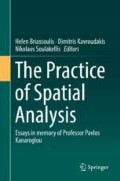Abstract
A recent application of the spatial transferability approach is to assess the potential impacts of the emerging connected automated mobility technology on people’s travel behavior at the national level. While there are a few transportation simulation frameworks which can account for potential impacts of this technology in a simulated geographical context, there is yet to be any literature documenting disaggregated estimates of large-scale impacts of connected automated vehicles (CAVs) on travel behavior at the national level. Therefore, in order to provide a platform to assess national-level impacts of CAVs, this study develops a methodological framework based on transferability techniques, which uses data and models from a smaller geographical area—the POLARIS simulation results for the CAVs scenario in the Chicago metropolitan area—to generate disaggregate travel data at the national level. Comparison of the distributions of the transferred variables at the regional and the national contexts indicates that the platform is capable of transferring travel behavior indices to the national level with high level of accuracy.
Access this chapter
Tax calculation will be finalised at checkout
Purchases are for personal use only
References
Auld, J., Hope, M., Ley, H., Sokolov, V., Xu, B., & Zhang, K. (2016). POLARIS: Agent-based modeling framework development and implementation for integrated travel demand and network and operations simulations. Transportation Research Part C: Emerging Technologies, 64, 101–116.
Auld, J., Sokolov, V., & Stephens, T. S. (2017). Analysis of the effects of connected–automated vehicle technologies on travel demand. Transportation Research Record, 2625, 1–8. https://doi.org/10.3141/2625-01.
Brown, A., Gonder, J., & Repac, B. (2014). An analysis of possible energy impacts of automated vehicle (pp. 137–153). Cham: Springer. https://doi.org/10.1007/978-3-319-05990-7_13.
Chiu, T., Fang, D., Chen, J., Wang, Y., & Jeris, C. (2001). A robust and scalable clustering algorithm for mixed type attributes in large database environment. In: Proceedings of the 7th ACM SIGKDD International Conference on Knowledge Discovery and Data Mining (pp. 263–268). http://doi.acm.org/10.1145/502512.502549.
Farber, S., Bartholomew, K., Li, X., Paez, A., & Nurul Habib, K. M. (2014). Assessing social equity in distance based transit fares using a model of travel behavior. Transportation Research Part A: Policy and Practice, 67, 291–303. https://doi.org/10.1016/j.tra.2014.07.013.
FHWA. (2009). U.S. Department of Transportation, Federal Highway Administration, 2009 National Household Travel Survey. [WWW Document]. Retrieved 3.1.17, from http://nhts.ornl.gov.
Golshani, N., Shabanpour, R., Mahmoudifard, S. M., Derrible, S., & Mohammadian, A. (2018). Modeling travel mode and timing decisions: Comparison of artificial neural networks and copula-based joint model. Travel Behaviour and Society, 10, 21–32. https://doi.org/10.1016/J.TBS.2017.09.003.
Greene, W. H. (2012). Econometric analysis (7th ed.). Boston: Pearson Education.
Li, Z., Wang, W., Yang, C., & Ragland, D. R. (2013). Bicycle commuting market analysis using attitudinal market segmentation approach. Transportation Research Part A: Policy and Practice, 47, 56–68. https://doi.org/10.1016/j.tra.2012.10.017.
Mohammadian, A., & Zhang, Y. (2007). Investigating transferability of National Household Travel Survey Data. Transportation Research Record, 1993, 67–79. https://doi.org/10.3141/1993-10.
Paulssen, M., Temme, D., Vij, A., & Walker, J. L. (2014). Values, attitudes and travel behavior: A hierarchical latent variable mixed logit model of travel mode choice. Transportation (Amst)., 41, 873–888. https://doi.org/10.1007/s11116-013-9504-3.
Shabanpour, R., Auld, J., Mohammadian, A. K., & Stephens, T. (2017a). Developing a platform to analyze behavioral impacts of connected automated vehicles at the national level. In: Proceedings of the 96th Annual Meeting of the Transportation Research Board (TRB), Washington, DC.
Shabanpour, R., Golshani, N., Derrible, S., Mohammadian, A., & Miralinaghi. (2017b). Joint discrete-continuous model of travel mode and departure time choices. Transportation Research Record: Journal of the Transportation Research Board, 2669, 41–51. https://doi.org/10.3141/2669-05.
Shabanpour, R., Golshani, N., Tayarani, M., Auld, J. & Mohammadian, A.K. (2018). Analysis of telecommuting behavior and impacts on travel demand and the environment. Transportation Research Part D: Transport and Environment, 62, 563–576. https://doi.org/10.1016/j.trd.2018.04.003.
Stephens, T. S., Gonder, J., Chen, Y., Lin, Z., Liu, C., & Gohlke, D. (2016). Estimated bounds and important factors for fuel use and consumer costs of connected and automated vehicles. National Renewable Energy Laboratory Technical Report NREL/TP-5400-67216. Retrieved from https://www.nrel.gov/docs/fy17osti/67216.pdf.
Van Acker, V., Goodwin, P., & Witlox, F. (2016). Key research themes on travel behavior, lifestyle, and sustainable urban mobility. International Journal of Sustainable Transportation, 10, 25–32. https://doi.org/10.1080/15568318.2013.821003.
Acknowledgments
The authors gratefully acknowledge the sponsorship of the Systems and Modeling for Accelerated Research in Transportation (SMART) Mobility Laboratory Consortium, an initiative of the Energy Efficient Mobility Systems (EEMS) Program, managed by David Anderson of the Vehicle Technologies Office of the U.S. Department of Energy. This study was conducted under Contract No. DE-AC02-06CH11357 to Argonne National Laboratory, a U.S. Department of Energy laboratory managed by UChicago Argonne, LLC. The authors are solely responsible for the findings of this research which do not necessarily represent the views of the U.S. Department of Energy or the United States Government.
Author information
Authors and Affiliations
Corresponding author
Editor information
Editors and Affiliations
Rights and permissions
Copyright information
© 2019 Springer International Publishing AG, part of Springer Nature
About this chapter
Cite this chapter
Shabanpour, R., Golshani, N., Stephens, T.S., Auld, J., Mohammadian, A. (2019). Developing a Spatial Transferability Platform to Analyze National-Level Impacts of Connected Automated Vehicles. In: Briassoulis, H., Kavroudakis, D., Soulakellis, N. (eds) The Practice of Spatial Analysis. Springer, Cham. https://doi.org/10.1007/978-3-319-89806-3_12
Download citation
DOI: https://doi.org/10.1007/978-3-319-89806-3_12
Published:
Publisher Name: Springer, Cham
Print ISBN: 978-3-319-89805-6
Online ISBN: 978-3-319-89806-3
eBook Packages: Earth and Environmental ScienceEarth and Environmental Science (R0)

